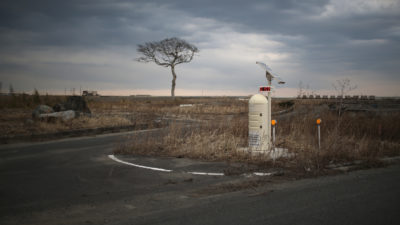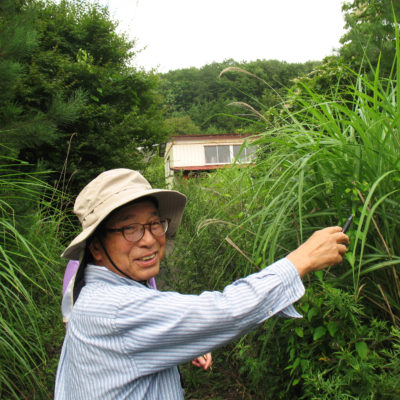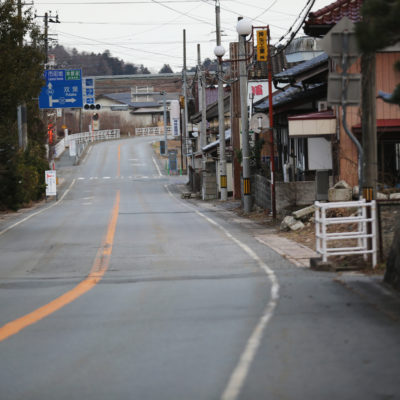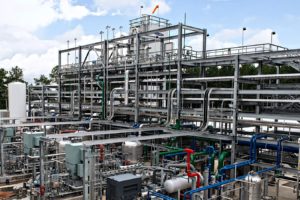Japan’s Highway 114 may not be the most famous road in the world. It doesn’t have the cachet of Route 66 or the Pan-American Highway. But it does have one claim to fame. It passes through what for the past five years has been one of the most radioactive landscapes on the planet – heading southeast from the Japanese city of Fukushima to the stricken nuclear power plant, Fukushima Daiichi, through the forested mountains where much of the fallout from the meltdown at the plant in March 2011 fell to earth.
It is a largely empty highway now, winding through abandoned villages and past overgrown rice paddy fields. For two days in August, I traveled its length to assess the aftermath of the nuclear disaster in the company of Baba Isao, an assemblyman who represents the town of Namie, located just three miles from the power plant and one of four major towns that remain evacuated.
At times, the radiation levels seemed scarily high – still too high for permanent occupation. But radiation was just the start. More worrying, I discovered, was the psychological and political fallout from the accident. While the radiation – most of it now from caesium-137, a radioactive isotope with a half-life of 30 years – is decaying, dispersing, or being cleaned up, it is far from clear that this wider trauma has yet peaked. Fukushima is going to be in rehab for decades.
I began my journey with Baba, a small bustling man of 72 years, at Kawamata, a town on Highway 114 that is a gateway to the mountains beyond. These mountains are where the fallout was greatest, and the forests that cover most of their slopes have retained the most radioactivity. The mountains make up most of the government-designated “red zone,” where radiation doses exceed 50 millisieverts a year and which are likely to remain uninhabited for many years.
A second “yellow zone” has doses of 20-50 millisieverts, where returning may soon be possible; and a third “green zone,” with less than 20 millisieverts, is deemed safe to live in, and an organized return is under way or planned. Zones are re-categorized as radioactivity decays and hotspots are decontaminated.
To check progress, I took with me a Geiger counter that measured gamma radiation, the main source of radiation for anyone not eating contaminated food.
Beyond Kawamata, the road was largely empty and houses sat abandoned and overgrown. There was no cellphone signal. At first, houses we measured at the roadside had radiation doses equivalent to only around 2 millisieverts per year, a tenth of the government threshold for reoccupation. But within minutes, as we climbed into the mountains, radiation increased as we moved from green to yellow to red zones.
Despite the radiation, wildlife is thriving in the absence of people, Baba said. There are elk, lynx, monkeys, and bears in the mountains. “Nature here is beautiful,” he said, “but we can’t fish or collect bamboo shoots or eat the mountain vegetables that people used to harvest from the forests.”
We stopped by an abandoned gas station in Tsushima, a village in the lee of Mount Hiyama, where wild boar had excavated the soil right by a vending machine that appeared remarkably intact. The bright-red digital display on an official Geiger counter read the equivalent of 21 millisieverts per year, just above the limit for human habitation.
The day after the disaster at the power plant began, 1,400 people from Namie came to Tsushima after being ordered to evacuate. “I was among them,” said Baba. “We had no information. People were just told to come. When we arrived, we went to the village police station and found that the police there were in full protective clothing against the radiation. They said it was a precaution in case they had to go to the power plant, but they had obviously been told that something serious was going on that the population hadn’t been told. That’s when our suspicion about the honesty of the authorities began.”
Tsushima has since become an unofficial shrine to the disaster. In the window of an abandoned shop are posters with bitter, ironic messages, some directed at the nuclear plant’s operator, Tokyo Electric Power: “Thanks to TEPCO, we can shed tears at our temporary housing,” read one. “Thanks to TEPCO, we can play pachinko.” But one, in English, just said, “I shall return.”
Back on Highway 114, a car stopped, and a woman got out. Konno Hideko was driving to Namie – day trips are allowed, but overnight stays banned – to clean her parents’ former house and tidy an ancestral grave before relatives visited during an upcoming religious holiday. “My parents are dead now, but I still clean their house,” she said. “There are mice inside and wild boar have been in. We won’t ever return to live there. But we might build a new house there one day.”
Further along, Baba stopped the car and walked up a path swathed in vegetation. “This is my house,” he said suddenly, pointing to a barely visible building. It was shuttered. But I noticed laundry still hanging to dry in an upstairs window. On a tour of the grounds, Baba showed me his plum trees. “The fruit is too dangerous to eat now, and we can’t drink the water from the well, either.” We found a shed where he and his schoolteacher wife once kept cattle, and a former hay shed where he stored old election banners.
(Left) Baba Isao approaches his abandoned house in Namie. (Right) A deserted street in Namie in early 2016. Fred Pearce/Yale e360. Christopher Furlong/Getty Images
I checked my meter. It read 26 millisieverts per year in the hay shed, but shot up to an alarming 80 in undergrowth outside. That was four times the safe level for habitation. No wonder Baba had no plans to return. “I am just the son of a farmer. I wonder who has a right to destroy our home and my livelihood,” he mused bitterly. “Please tell the world: No Nukes.”
At his local post office, an official monitor by the road measured 56 millisieverts. Mine agreed, but when we pointed it close to a sprig of moss pushing through the tarmac, it went off the scale. “They measured 500 millisieverts here last week,” Baba said. “Moss accumulates radioactivity.”
As we drove on, the roadside was now marked every few kilometers by massive pyramids of black plastic bags, containing radioactive soil that had been stripped from roadside edges, paddy fields, and house gardens as part of government efforts to decontaminate the land. An estimated 3 million bags, all neatly tagged, now await final disposal at facilities planned along the coast. But the task of transporting the soil is so huge that the authorities are building a new road so trucks can bypass the scenic mountain villages along Highway 114.
Through a checkpoint we came at last to Namie town. Just before my visit, major media such as The Guardian and CNN had published images of the town by a photographer who claimed to have gained secret, unauthorized entry to the “ghost town.” He posed in his images wearing a gas mask to show how dangerous it was.
My visit to the town had required a request in advance, via Baba, but no subterfuge. And I found Namie a surprisingly busy “ghost town.” Nobody is yet allowed to live there. But some 4,000 people work there every day, repairing the railway line and roads, building new houses, and knocking down quake-damaged shops, preparing for the planned return of its citizens in April 2017.
There was plenty of earthquake damage, and vegetation pushed through cracks in the roads and the pavement in the front yards. Black bags were everywhere. But the traffic lights functioned, and drivers obeyed them; there was a 7-Eleven and the vending machines had Coke in them. Nobody wore protective clothing or masks. My biggest safety concern was not radiation, but the news, conveyed over the town’s public address system on the afternoon I was there, that a bear had been spotted in the suburbs.
Despite its proximity to the power plant, average radiation levels in the town were down to around 2 millisieverts per year in Namie – lower, in fact, than I recorded in Fukushima City, which was never evacuated.
“I have no idea how many people will come back,” said Baba. “They have a lot of misgivings because of the radioactive contamination. And I think their fears are totally justified. It is totally unthinkable for me to return to my old place, so I cannot encourage them to return to theirs.” He quoted a survey of the town’s 21,000 former residents showing that only 18 percent wanted to come back. That sounded similar to nearby Naraha town, where only a fifth returned after the all-clear was given last year.
People especially feared for their children. The biggest concern was reports of an epidemic of thyroid cancer among children exposed to radioactive iodine in the days after the accident. An ultrasound screening program had found an apparent 30-fold increase in cysts, nodules, and some cancers in children’s thyroid glands. It had made headline news. But at the Fukushima Medical University, doctors and medical researchers insisted that radiation doses were far too low to pose a serious cancer risk, not least because contaminated foodstuffs that could have harbored the iodine were rapidly withdrawn from sale. Ken Nollet, an American who is director of radiation health at the university, insists that the apparent epidemic was evidence only of better searching for disease. He told me a Korean screening study using the same techniques on a non-exposed population found similar rates to those in Fukushima’s contaminated zone. Thanks to the rapid, if chaotic, evacuation of the area after the power plant began its meltdown, and the controls of foodstuffs, doctors say they believe there are unlikely to be many, if any, deaths among the public from radiation from the Fukushima accident. “A few members of the public got a CT scan’s worth of radiation; almost nobody received more than the dose from a barium meal,” said Nollet. But there have been deaths nonetheless. Some 60 old people died as a direct result of the evacuation, including several who died of hunger after being left behind, said a doctor at Soma hospital, Sae Ochi. And depression remains widespread among evacuees, she says. There have been around 85 suicides linked to its after-effects. “It’s post-traumatic stress,” said Masaharu Maeda at Fukushima Medical University. “People with very negative views about the risks of radiation are more likely to be depressed. It’s a vicious circle.” Some doctors told me that while the initial evacuation was necessary, the failure to plan a swift return as radiation levels fell had been disastrous. Apart from a few high-dose areas in the mountains, the psychological risks of staying away exceed the radiological risks of coming back. But the confusion has contributed to a serious loss of trust among the public for medical, as well as nuclear, authorities. “When we try to explain the situation,” says Nollet, “we are seen as complicit in nuclear power.”
It seems increasingly unlikely that the majority of families will return to the abandoned towns as the official all-clear is given. As we drove back from Namie, I dropped in on a group of old women living in an evacuation camp outside Kawamata. One told me they wanted to return to their old homes, but that “most young people simply won’t go back. They fear for their children, but also they have moved on in their lives, with new jobs and their children in new schools.” And maybe that is not a bad thing. At a kindergarten in Soma City, just outside the exclusion zone, teachers told me that, away from the fear of radiation, there was a baby boom going on there. The crop of new students this year was the largest since the accident.






